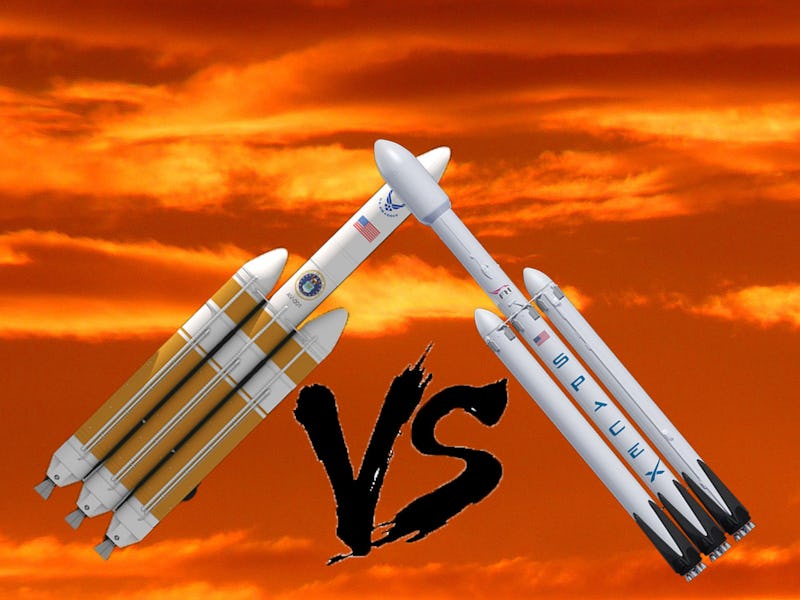SpaceX’s Falcon Heavy flexed on its competition in February when it successfully launched Elon Musk’s Tesla Roadster into space. This historical flight made it the most powerful operation rocket, dethroning the United Launch Alliance’s (ULA) Delta IV Heavy from its No. 1 spot.
Both of these orbital launch systems are cutting-edge in the aerospace game. They both fall into the category of heavy-lift launch vehicles, which means they need to be able to lift at least 44,092 pounds (20,000 kilograms) to low Earth orbit. Both of these boosters can easily blast that much weight past the atmosphere, making them the two most powerful operational rockets.
Here’s how both heavyweights stack up against each other.
SpaceX Falcon Heavy vs. Delta IV Heavy: Sheer Mass
For starters, both rockets are extremely heavy, but Falcon Heavy is just about double the weight of Delta IV Heavy, clocking in at 3,132,301 lb. (1,420,788 kg) and 1,616,000 lb. (733,000 kg) respectively. Absolute unit.
According to the San Diego Zoo, a male hippopotamus can weight up to 9,920 lb (4,500 kg), which means Falcon Heavy would weigh roughly the same as 316 really big hippos.
This drastic weight difference is pretty shocking when you take into account that Delta IV Heavy is 6 feet (2 meters) taller than Falcon Heavy. SpaceX’s rocket truly lives up to its name.
SpaceX Falcon Heavy vs. Delta IV Heavy: Reusability
SpaceX has pioneered reusable rocket technology, which allows the company to launch the same cores over and over again saving both time and money. Falcon Heavy was designed to be fully reusable; however, during its maiden launch its central core crash-landed into the Atlantic Ocean. There’s always room for improvement.
On the other hand Delta IV Heavy is a completely expendable launch system, meaning not one part of it can be reused after a launch. The best engineers can do is salvage materials from its wreckage to be recycled.
SpaceX Falcon Heavy vs. Delta IV Heavy: Carrying Capacity
Both of these bestial rockets can put up some serious weight, but Falcon Heavy is the winner in this squatting competition. It can put a 140,700 lb (63,800 kg) payload into lower Earth orbit (LEO) and a 58,900 lb (26,700) payload into geostationary orbit (GTO). According to National Geographic, Asian Elephants can weight up to 11,000 lb (5,000 kg). This means Falcon Heavy could send about 13 elephants into LEO and five of them into GTO. Imagine a herd of elephants riding on the wings of a thicc Falcon. Absolutely majestic.
Delta IV Heavy doesn’t have anything on SpaceX’s booster in this department. The ULA’s creation can carry 63,470 lb (28,790 kg) into LEO and 31,350 lb (14,220 kg) into GTO. That translates to a measly six elephants into LEO and just about three into GTO.
SpaceX Falcon Heavy vs. Delta IV Heavy: Engines
Delta IV Heavy and Falcon Heavy both use a two-stage rocket design, which means it burns through all the fuel in one of its engines and immediately activates another mid-flight. Falcon Heavy is the equivalent of three Falcon 9 rockets being strapped together. This means it uses nine of SpaceX’s proprietary Merlin 1D engines during its ground stage and its first stage, which guzzle up supercooled liquid oxygen to blast off. For its final stage, it makes use of the Merlin 1D-Vacuum, which Elon Musk said can generate 80 tons of thrust.
Delta IV Heavy, on the other hand, utilizes far fewer engines during takeoff. These include the RS-68A engine for its first stage and the RL10-B-2 for its second stage. Both of these use a mixture of liquid hydrogen and liquid oxygen as propellants.
